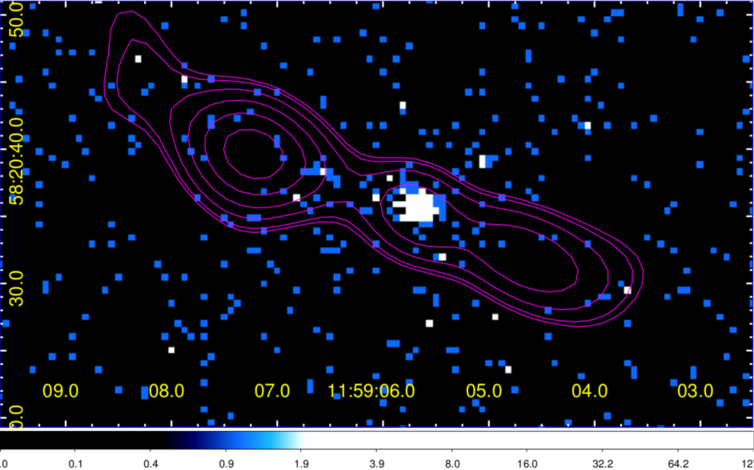Astronomy Object of the Month: 2021, November
< previous Archive next >
Ionized Iron Line in Radio Galaxy CGCG 292–057
Active Galactic Nuclei are
Supermassive Black Holes
residing in the centres of massive galaxies and accreting material at higher rates. Astronomers
classify galaxies of three types: spirals, ellipticals and irregulars. If elliptical (early-type)
galaxies and spiral or irregular (late-type) galaxies merge with one another, it may result in an
X-shaped galaxy which is luminous in radio wavelengths.

Illustration 1:
The Chandra ACIS-S image of CGCG 292−057, with the superimposed 606 MHz radio contours from GMRT
radio array. The white contours display the outer structure of the radio source, while the magenta
ones map the inner radio structure. The Chandra image displays the 0.5–7.0 keV counts, smoothed
with a 3 px radius Gaussian. Credit: The Authors.
There is presence of ionized atoms in the centre of CGCG 292-057. At the nucleus of the galaxy, there is a nuclear spectrum with atoms such as O+, N+,S+ – so-called Low-Ionization emission line-region (LINER). The morphology of CGCG292-057 has multiple components and plasma materials of various sizes. It has outer lobes extending up to ~230 kpc and inner lobes up to ~20 kpc. Active galaxies used to have two opposite jets emanating from the central engine, up to few millions years old, that are intermittent in nature. In the case of CGCG 292−057, one can potentially witness all the aforementioned processes at work, imprinted in the complex morphology of its radio jets and lobes, as well as in its host galaxy.
Due to the presence of such peculiar characteristics, astronomers from Astronomical Observatory of the Jagiellonian University recently published a detailed analysis on the general spectral properties of the CGCG 292−057 nucleus, with those of other nearby LINERs studied in X-rays, using data collected by the Chandra X-ray observatory and making use of the unprecedented combination of the excellent angular resolution and high sensitivity of the Advanced Chandra Imaging Spectrometer instrument.

Illustration 2:
The Chandra ACIS-S image (0.5–7 keV counts) of CGCG 292−057 host galaxy, with the superimposed 606 MHz
GMRT contours of the inner radio structure (same as in Illustration 1). Credit: The Authors.
The active nucleus of the system has 393 net counts within the 0.5-7.0 keV range in the 2.5 arc sec radius, surrounded by a diffuse, low surface brightness emission. We carefully studied the Chandra Point spread function and the surface brightness profile, and in this way we found evidence for the presence of an excess X-ray emission component at kpc distances from the centre, which was quantified by Kolmogorov-Smirnov test. There is an excess emission from about 5 kpc from the centre, whose temperature is 0.8 keV. This is due to the result of compression and heating of the fraction of diffuse interstellar medium, heated due to expanding tiny jets emitting in the radio wavelengths.
The 0.5-7 keV spectrum of the CGCG 292−057 nucleus clearly displays an ionized iron line at ∼6.7 keV, with no accompanying neutral feature at 6.4 keV. We modelled the spectrum assuming various emission models, and concluded that a simple power-law or either thermal fits imply unphysical photon indices or equivalently very high and unconstrained plasma temperatures. The best fit is obtained assuming a phenomenological model consisting of a relatively steep-spectrum with a slope ~1.8. The X-ray continuum emission was absorbed by a relatively large amount of cold material with hydrogen atoms of the order 1023 cm-2 which was partially scattered by a cloud of ionized gas. The X-ray luminosity of the direct nuclear continuum at this phenomenological model is of the order ~1041 erg s-1. Photoionized gaseous material is located at ~0.02 light-years of the Broad-Line Region of the source. The spectrum has an observed equivalent width of the Fe XXV Kα line, which is of the order of 0.3 keV.
We compare the general spectral properties of the CGCG 292−057 nucleus with those of other nearby LINERs studied in X-rays, and argue that the system appears under-luminous in X-rays for its bolometric disk luminosity, and at the same time over-luminous in radio – In fact, on the radio-loudness vs. accretion rate plane. CGCG 292−057 is located almost exactly in between the populations of Seyferts+LINERs. This may be also hosted by disk galaxies and radio galaxies, which are typically of the elliptical shape.
Original publication: K. Balasubramaniam, Ł. Stawarz, V. Marchenko, M. Sobolewska, C. C. Cheung, R. Thimmappa, and E.Kosmaczewski, Chandra View of the LINER-type Nucleus in the Radio-Loud Galaxy CGCG 292057: Ionized Iron Line and Jet-ISM Interactions, 2020, The Astrophysical Journal, 905, 148.
The research was conducted at the Department of High Energy Astrophysics of the Jagiellonian University’s Astronomical Observatory (OAUJ). The research used data obtained from the Chandra Data Archive. The work was partially financed by the NCN grant 2016/22/E/ST9/00061.
|
Karthik Balasubramaniam Astronomical Observatory Jagiellonian University K.Balasubramaniam [at] oa.uj.edu.pl |


